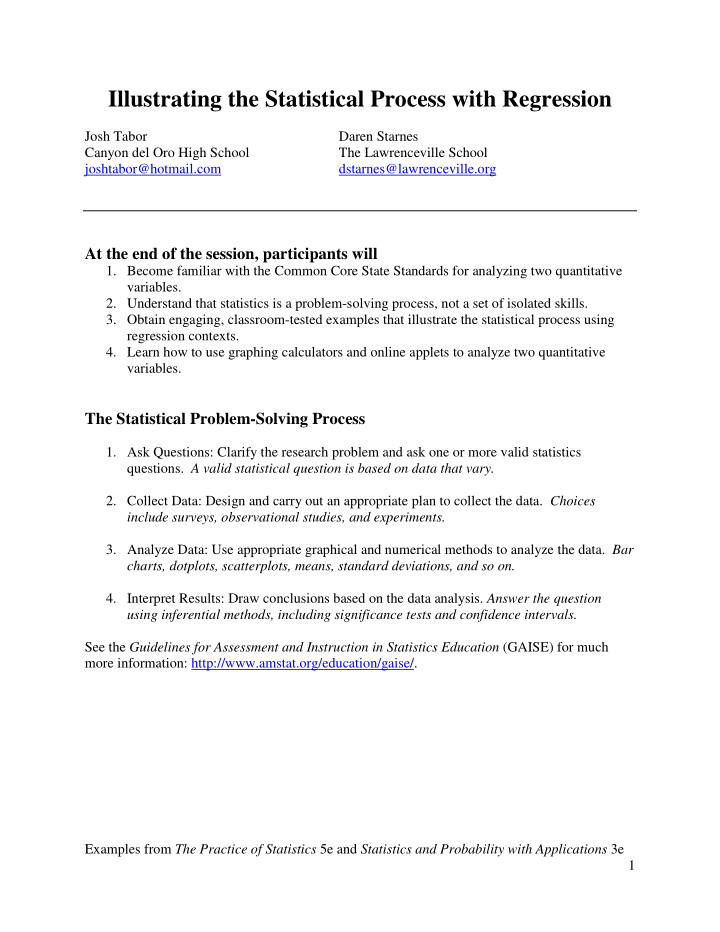



Illustrating the Statistical Process with Regression Josh Tabor Daren Starnes Canyon del Oro High School The Lawrenceville School joshtabor@hotmail.com dstarnes@lawrenceville.org At the end of the session, participants will 1. Become familiar with the Common Core State Standards for analyzing two quantitative variables. 2. Understand that statistics is a problem-solving process, not a set of isolated skills. 3. Obtain engaging, classroom-tested examples that illustrate the statistical process using regression contexts. 4. Learn how to use graphing calculators and online applets to analyze two quantitative variables. The Statistical Problem-Solving Process 1. Ask Questions: Clarify the research problem and ask one or more valid statistics questions. A valid statistical question is based on data that vary. 2. Collect Data: Design and carry out an appropriate plan to collect the data. Choices include surveys, observational studies, and experiments. 3. Analyze Data: Use appropriate graphical and numerical methods to analyze the data. Bar charts, dotplots, scatterplots, means, standard deviations, and so on. 4. Interpret Results: Draw conclusions based on the data analysis. Answer the question using inferential methods, including significance tests and confidence intervals. See the Guidelines for Assessment and Instruction in Statistics Education (GAISE) for much more information: http://www.amstat.org/education/gaise/. Examples from The Practice of Statistics 5e and Statistics and Probability with Applications 3e 1
Grade 8 » Statistics & Probability Investigate patterns of association in bivariate data. 8.SP.A.1 Construct and interpret scatter plots for bivariate measurement data to investigate patterns of association between two quantities. Describe patterns such as clustering, outliers, positive or negative association, linear association, and nonlinear association. 8.SP.A.2 Know that straight lines are widely used to model relationships between two quantitative variables. For scatter plots that suggest a linear association, informally fit a straight line, and informally assess the model fit by judging the closeness of the data points to the line. 8.SP.A.3 Use the equation of a linear model to solve problems in the context of bivariate measurement data, interpreting the slope and intercept. For example, in a linear model for a biology experiment, interpret a slope of 1.5 cm/hr as meaning that an additional hour of sunlight each day is associated with an additional 1.5 cm in mature plant height . High School » Interpreting Categorical & Quantitative Data (S-ID) Summarize, represent, and interpret data on two categorical and quantitative variables HSS.ID.B.6 Represent data on two quantitative variables on a scatter plot, and describe how the variables are related. HSS.ID.B.6.A Fit a function to the data; use functions fitted to data to solve problems in the context of the data. Use given functions or choose a function suggested by the context. Emphasize linear, quadratic, and exponential models. HSS.ID.B.6.B Informally assess the fit of a function by plotting and analyzing residuals. HSS.ID.B.6.C Fit a linear function for a scatter plot that suggests a linear association. Interpret linear models HSS.ID.C.7 Interpret the slope (rate of change) and the intercept (constant term) of a linear model in the context of the data. HSS.ID.C.8 Compute (using technology) and interpret the correlation coefficient of a linear fit. HSS.ID.C.9 Distinguish between correlation and causation. Examples from The Practice of Statistics 5e and Statistics and Probability with Applications 3e 2
Example 1: Seating Charts Ask Questions Collect Data Analyze Data 1 1 1 1 2 2 2 2 3 3 3 3 4 4 4 4 4 76 77 94 99 83 85 74 79 90 88 68 78 94 72 101 70 79 5 5 5 5 5 6 6 6 6 7 7 7 7 76 65 90 67 96 88 79 90 83 79 76 77 63 Applet available at: www.tinyurl.com/SPAapplets Interpret Results Examples from The Practice of Statistics 5e and Statistics and Probability with Applications 3e 3
Example 2: Ford F-150s Ask Questions Collect Data Analyze Data 70,583 129,484 29,932 29,953 24,495 75,678 8,359 4,447 21,994 9,500 29,875 41,995 41,995 28,986 31,891 37,991 34,077 58,023 44,447 68,474 144,162 140,776 29,397 131,385 34,995 29,988 22,896 33,961 16,883 20,897 27,495 13,997 Interpret Results Examples from The Practice of Statistics 5e and Statistics and Probability with Applications 3e 4
Recommend
More recommend